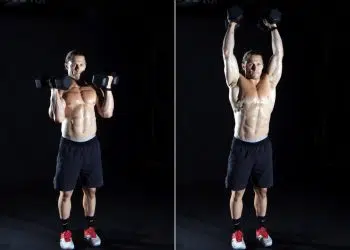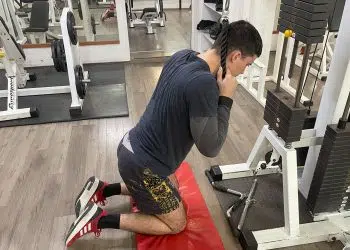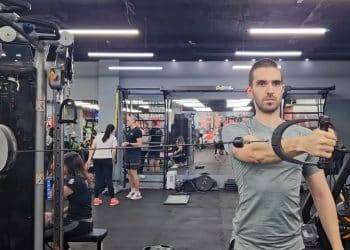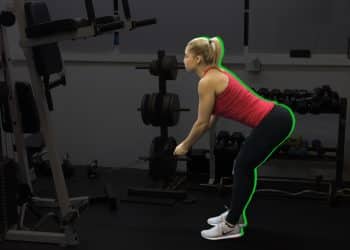If you’re not already incorporating cable curls into your workouts then you’re leaving arm gains on the table. Few if any, training tools, offer a combination of machine tension and the freedom of freeweight movement plus core activation. Cable curls and its variations should be a main go-to for your best arm training sessions because of their versatility and the superior mind-muscle connection that you get with this variation.
Check out our full cable curls exercise guide that includes training tips, a list of benefits, best variations, recommended sets and reps and more.
How To Do Cable Curls
There’s a preferred technique for each and every exercise variation based on how the muscles work. You want to keep tension on the target muscles throughout the range of motion to maximize the contraction and stretch phase of a repetition and minimize assistance from surrounding muscles.
Step 1: Setup and proper form
- Attach a medium or long bar handle to the bottom of the cable machine. You can also use two single grip handles attached to two separate cable stacks positioned close to each other.
- Form a solid base with your feet roughly shoulder-width apart, then squat down and grip the bar a little wide so your hands are about shoulder-width too.
- Keep your upper arms pressed into your torso, pull your shoulders back, bend slightly at the hip and knees and tense your core muscles.
Pro tip: Squeeze the bar tight in your hands to activate the arm muscles.
Step 2: The curl and squeeze
Now you’ll curl the bar up using your biceps muscles and squeeze hard at the top for 2 seconds.
Step 3: Eccentric/triceps flex
To finish, slowly straighten your arms back to the starting position, fully extend your elbows and flex your triceps muscles.
Level Up Your Fitness: Join our 💪 strong community in Fitness Volt Newsletter. Get daily inspiration, expert-backed workouts, nutrition tips, the latest in strength sports, and the support you need to reach your goals. Subscribe for free!
Pro tip: Triceps flexion pre-stretches the muscles and amplifies the biceps contraction.
Below we’ve included a detailed video demonstration and explanation of how to do cable curls the right way.
Benefits
What advantages do cable curls have over other biceps variations?
Machine tension and freeweight movement
Cables are a unique training tool because they combine machine and freeweight elements. For example, regardless of your body position, the cables provide constant tension at every angle. But unlike a machine that locks you into a predetermined path, you have more freedom of movement. That means you need to activate stabilizers and total body coordination and balance.
Endless variations
The one thing about cables that isn’t possible with other forms of exercise is you can angle your body any way you like and still work the target muscle group. Additionally, you can attach a wide variety of handles and grips based on your preference.
Related: The 12 Best Cable Machine Exercises for Bigger Biceps and Workout
Drawbacks
Every form of exercise has its pros and cons and these are the potential drawbacks of cable curls.
Requires a cable machine
Most people don’t have a cable machine at home, therefore, most people will need a gym membership to take advantage of this superior biceps movement. And hopefully, the cable stations aren’t crowded or being repaired.
Common Mistakes
Using sloppy form – Many use cables as an excuse to toss proper lifting technique out the window because they figure there’s always tension so they can swing the weight up and it’ll still stimulate the biceps. The one thing you need to especially pay attention to is keeping the bar level and even during the curls. We tend to have a more dominant arm and if you don’t focus, that side will take over and you’ll take half the load off of one side, causing left to right side imbalance.
A good way to avoid this is to keep your eyes open and on the bar. If you can train in front of a mirror, that’s also a good way to avoid this issue.
Lifting too heavy – For the same reason we listed the first common mistake, the same applies to this one too. Don’t abuse cables at the expense of proper form or your back.
Variations
The following variations are similar to cable curls in that there’s constant tension on the muscle at all times.
Level Up Your Fitness: Join our 💪 strong community in Fitness Volt Newsletter. Get daily inspiration, expert-backed workouts, nutrition tips, the latest in strength sports, and the support you need to reach your goals. Subscribe for free!
1. Seated cable curls
While not as convenient, you can steal a bench from the dumbbells section and set it up in front of the cable machine for more training variety. One of the best biceps exercise with cables is sitting facing away from the machine and allowing the cables you pull and stretch your biceps. You’ll get a killer muscle contraction this way.
2. One arm cable curl
Training one arm at a time allows you to position your arm at various angles to exacerbate the biceps contraction. For example, one variation you can do with the one arm version is cable curl is cross body curls possibly emphasizing the outer biceps head.
Learn about the benefits of unilateral training here.
3. Band curls
Resistance bands are the cheaper, more convenient and portable version of a cable machine, ideal for home training. They keep tension on the working muscles just the same, although they’re not quite as versatile.
4. Machine curls
You gotta have access to a gym to use this variation but they just keep getting more ergonomic and state of the art. Locking you into position, there’s zero stability and balance because there’s typically no free movement. Therefore, you’re free to focus solely on the lift.
Try these 9 Best Cable Exercises for Bigger Biceps.
Programming Cable Curls In Your Workouts
What are the best ways to incorporate cable curls in your biceps training regime? Here are some tips to maximize this exercise and use them to make arm gains.
Multi-exercise biceps workout
If you’re going to structure an arm workout, the common strategy is to start with a heavy bilateral compound freeweight variation first (e.g., barbell curls), followed a unilateral exercise (e.g., dumbbell curls), and then a machine or cable variation to finish.
But cable curls can be placed at the beginning, middle or end of a workout because you can do them bilaterally (barbell attachment) or unilaterally (single grip attachment).
Primary/secondary
Some people like to structure their workouts by training their larger muscles first and smaller muscles secondary. For example, you could train the larger chest muscles first followed by the triceps or chest and biceps is another popular pairing. Typically, your overall workout split preference will determine how you combine muscle groups.
Finisher
The cable biceps curl is a great way to finish off a workout and it’s the perfect standalone exercise because you can focus on mind-muscle connection and end your workout feeling accomplished.
Drop sets
Cables and machines offer the most convenient way to use the drop set training method. That’s because you can do a heavier set and then quickly lower the weight by moving the pin down a few spots to decrease the workload and continue banging out reps to annihilate the biceps.
When you normally reach failure during an exercise, it usually means the end of a set. But drop sets allow you to lift heavy for as many reps as you can, drop the weight a certain percentage, rep out to failure and do that several times until you hit a target rep range. You’re essentially extending the set beyond what you’d normally be able to do if you stuck with just one weight for a set. The technique is based on the theory that you can stimulate more growth by prolonging the muscle tension that occurs during the contraction and lengthening of a muscle during a particular movement.
How Many Sets and Reps?
The optimal sets and reps range depends on your experience level and goals. However, for best all-around results and to prevent training boredom and challenge yourself, we recommend using a variety of reps, as well as to emphasize different muscle fiber types.
- Strength: 4-6 reps
- Hypertrophy: 6-12 reps
- Hypertrophy and muscle endurance: 15-30+ reps to failure
Muscles Worked
Curls aren’t just a biceps-only exercise. Other muscles are also involved to help assist and stabilize during the movement. The following section details the anatomy and function of these muscle groups.
- Biceps brachii – The biceps brachii or biceps for short is a two-headed muscle located on the anterior or front of the upper arm. The biceps crosses the elbow and shoulder joint and therefore functions at both ends, although its primary function is at the forearm end where it supinates and flexes the elbow.
- Brachialis – sandwiched between the outer biceps head and triceps, brachialis extends from the outer upper arm and crosses the elbow joint, making it a primary elbow flexor muscle. When well developed, the brachialis contributes to upper arm width and is most visible on a lean physique.
- Brachioradialis – Making most of the lateral upper forearm, brachioradialis crosses the elbow and is hence a primary elbow flexor. It also supinates and pronates the forearm (flipping the palm up and down respectively) and is involved in all pulling and curling exercises.
- Core muscles – The core consists of several muscles – abs (curls the pelvis and rib cage toward each other), obliques (located on either side of the abs and rotate the torso), deeper core muscles (transverse abdominis and internal obliques draw the belly button to the spine and stabilize the trunk), back extensors (allow us to stand up straight from a bent-over position and lean backward). The core muscles need to be activated to stabilize the spine during curls.
Bottom Line
Few exercises offer different training elements in one while allowing you to maintain tension on the muscles regardless of how your body is positioned or angled. Not to mention, the many choices that you have for attachments, giving you so many options to choose from based on your preferences.
For best gains, you should include a variety of training tools including freeweights, bodyweight, machine and cables. Each has its own advantages and it makes training exciting, motivating, and is results-based.
Interested in measuring your progress? Check out our strength standards for Barbell Curl, Dumbbell Curl, Squat.











